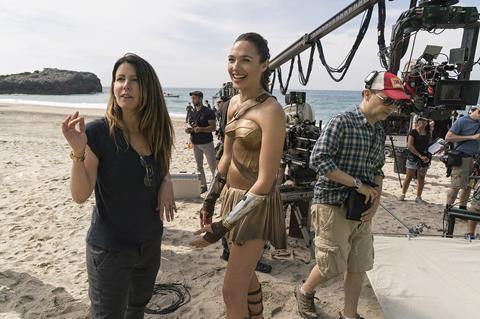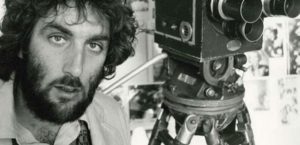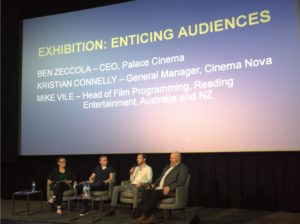Oscar heavyweight Lion has earned more at the Aussie box office than all of last year’s local films combined – not bad for a filmmaker making his feature debut.
Garth Davis was approached about the project by See-Saw Films’ Iain Canning and Emile Sherman at the Sundance Film Festival, where the trio were premiering the first season of Top of the Lake.
Davis heard the story and raced off to his lodge to read up on the extraordinary case of Saroo Brierley, a small boy adopted by an Australian couple after falling asleep on a train and waking up on the other side of India, unable to find his way home.
Angie Fielder, Luke Davies, star Dev Patel, Garth Davis and DP Greig Fraser.
To map out Brierley’s story, the producers turned to screenwriter Luke Davies, an old collaborator.
Davies had worked on Candy, based on his own autobiographical novel, with Sherman producing, while Canning was the film’s European sales agent and an executive producer. Canning and Sherman became friends, formed See-Saw and went on to make The King’s Speech.
On Lion, the producers turned to Aquarius Films’ Angie Fielder to lead the production process and work closely with Davis. Fielder jumped on-board in late 2013, before there was a script.
Davies’ work on the film began with what he describes now as “a really intense research trip.”
Over two and a half weeks, the writer travelled to India to with Saroo to visit key locations, then on to Tasmania to meet Saroo’s family and friends with Davis.
“About two weeks after that Garth came to LA and he and I sat down with a whiteboard for about a week or ten days,” recalls Davies. “Very casual, cups of tea all day long, filling up his whiteboard, throwing ideas around.”
Davis remembers “lots of conversations about what we liked about the story, [and] the rhythms of it. There’s a lot of emotional engineering going on. Obviously the more practical question was: what’s the structure of the film?”
After that initial session, story meetings continued via conference call, with Davies back and forth between Sydney and LA, Davis in Melbourne, Fielder and Sherman in Sydney and Canning in London.
“There were a lot of calls at odd hours of the day and night,” says Fielder. “We started out with a beat sheet and then moved to a treatment and then moved to draft.
The film’s chronological structure was decided upon early.
“It would have been much more conventional and probably much safer to start the film with Saroo as an older man,” says Fielder. “So you start the movie with Dev Patel and Nicole Kidman and flash back to what happened to him in India.”
“But Luke was very committed to the idea of trying to tell it in a linear way. We really wanted to put people in Saroo’s head, and when you tell the story to other people, you don’t start with: ‘there’s this guy living in Tasmania and then one day he decided to look for home’. You tell the story from the beginning – there’s a little boy from a small village in India and he gets stuck on a train and gets lost.”
“We knew it was a risk, because we were essentially making a film in which the first fifty minutes were in India with very little dialogue and what dialogue there was was in Hindi or Bengali. But we were very lucky in that we found Sunny Pawar, who plays little Saroo, and his performance is so compelling that I think the audience doesn’t actually realise that they’re in a non-English language film.”
Davies wrote the first draft in less than twelve weeks, then another after notes, in what he describes as “a really rapid, compressed, six month period. Six months, two drafts,with gaps in between.”
That draft was shopped at the Cannes Film Festival in May 2014, where The Weinstein Company snapped up international rights, completing a financing pie that included Screen Australia, location attraction money from Film Victoria and a distribution advance from Transmission.
The filmmakers spent 2014 scouting India, did a large-scale tech recce in September and began official pre in November.
“We wanted to get into production as soon as we could,” says Fielder. “We were a little bit limited by the weather in India and not wanting to shoot in monsoon season.”
For Davis, the realisation that a five-year old had to hold the first half of the movie was “a pretty sobering concept.”
Finding the right child to play Saroo took around five months, with casting director Kirsty McGregor enlisting a local casting agent, Tess Joseph, who suggested the team focus on three cities.
“We went to schools over four months,” recalls Davis. “We couldn’t go to the streets because the kid we cast had to go to Australia, so we had to get them a visa and they had to have some sort of paperwork. So our net was a lot smaller, and we needed a kid that was quite streetwise – that was tricky.”
Visiting schools, Joseph would film 30-second scene with kids who would come in, do a scene, take a photo, then move off.
“Hundreds of children would arrive in my Dropbox every week, and I’d go through and put little coloured dots on good/bad/fair whatever, and over the months we developed a shortlist of a few hundred children,” says Davis.
Davis and McGregor later flew to India with Miranda Harcourt, an acting coach from New Zealand.
“We met up with Tess and her team and we workshopped the children for about two weeks in three cities,” says Davis.
“And if we found someone we liked, we’d bring them back every day for three days to see if they would return; whether the parents would cope with it, kind of testing their filmmaking stamina. Because so much rested on this performance.”
The Lion team tapped production services company India Take One Productions, an old hand at servicing foreign productions such as Slumdog Millionaire, Eat Pray Love and Zero Dark Thirty, to help them navigate the bureaucracy and work through the preparation time.
“They provided us with all the crew and helped us cast the whole thing,” says Fielder. “They were invaluable.”
When it came to crewing up, Fielder adopted the “mirror system”.
“This is something I’ve done on all the foreign shoots we’ve done at Aquarius: Wish You Were Here was Cambodia, Berlin Syndrome was Berlin. You bring your own HODs, your own first AD, your own cinematographer, your own production designer, costume designer. And then you also have a local working in a similar capacity but reporting to your head of department. Because they come with their own team, they’ve got their own networks and contacts.”
The one exception was the camera department, which was brought over wholesale from Oz, right down to the data wranglers.
“That’s a department you don’t really want to hand over to anybody else,” says Fielder.
Lion began shooting at the beginning of 2015, with six weeks scheduled in India and four in Oz.
Fielder describes shooting in India as “Great. Not without its challenges.”
“You’re dealing with language barriers, cultural barriers, a really harsh local environment, and a system that is heavily bureaucratic. It means you need a lot of lead-time in your preparation, which is why we spent the whole of 2014 going back and forth to India setting everything up.”
While editing the director was also on the hunt for a composer, listening to music endlessly.
“I landed on Hauschka [Volker Bertelmann] and Dustin O’Halloran. Both beautiful musicians but different. Hauschka had this childlike, raw quality, and I thought he really suited India. And then Dustin had that emotional quality.”
“I love movies like The Mission and The Piano where the music is very front and centre, which has been lost a little bit in cinema. Everyone’s very anti-music. I wanted to bring back that emotional music, and I thought Dustin did great melodies.”
Bertelmann happened to be playing at the Melbourne Recital Centre while Davis was in post, and the director went along.
“I was sitting there and he goes, ‘this piece of music is like being in a train with the window open and the landscape flashing by’. I thought: that’s so weird.”
After the show Davis caught up with Bertelmann and asked about collaborating with O’Halloran on a film score, only to learn that O’Halloran had been the best man at his fellow muso’s wedding. A deal was struck.
The film has racked up award nominations – and big box office – ever since TIFF, even though “a lot of the reviews weren’t great, actually, after that [Toronto premiere],” Davis
admits.
“That’s a wake-up call, as a filmmaker. But I do know we have the audience.”
As for Davies, who’s now working on projects with several Aussie filmmakers, including David Michôd and Kim Farrant, he cries every time he sees it.
“I shouldn’t, because I wrote it, so I know everything that happens, but I do and I think it is because Garth’s a magician. He made me an observer again.”
By Harry Windsor – INSIDEFILM – [Fri 31/03/2017]


